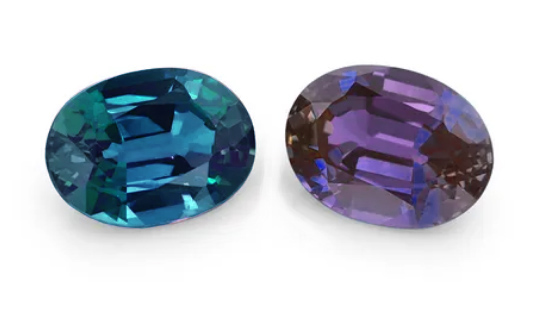Synthetic Alexandrite: Gemstone Information
Synthetic alexandrite, an impressive gemstone known for its remarkable color-changing properties, holds a special place in the world of synthetic gems. While natural alexandrite is exceedingly rare and valuable, synthetic alexandrite offers an affordable alternative that mimics the unique optical characteristics of its natural counterpart. Here’s an exploration of synthetic alexandrite, including its history, production methods, characteristics, and significance.
History:
The discovery of alexandrite, a variety of chrysoberyl, is credited to the Russian mineralogist Nils Gustaf Nordenskiöld in the early 19th century. It was named in honor of the Russian tsar, Alexander II, and became the national gem of Russia. Due to its scarcity and exquisite color-changing abilities—from greenish-blue in daylight to purplish-red under incandescent light—natural alexandrite gained legendary status and became highly coveted among gemstone enthusiasts.
Production Methods:
Synthetic alexandrite is created through various laboratory techniques, primarily the flux method and the hydrothermal method. In the flux method, aluminum oxide, beryllium oxide, and chromium oxide are melted together with additional elements in a crucible to mimic the natural conditions that produce alexandrite. The resulting crystals are then carefully cut and polished to enhance their optical properties. The hydrothermal method involves growing crystals from a superheated water solution containing the necessary chemical constituents. Both methods yield synthetic alexandrite with similar optical properties to natural alexandrite.
Characteristics:
Synthetic alexandrite shares many of the optical properties of its natural counterpart. It typically exhibits a color change from bluish-green or teal in daylight to reddish-purple or raspberry-red under incandescent light. This color change phenomenon, known as the alexandrite effect, is due to the presence of chromium ions in the crystal structure, which absorb certain wavelengths of light and cause the observed color shift. Synthetic alexandrite may also display asterism (the star effect) under certain lighting conditions, further enhancing its beauty and allure.
Significance:
Synthetic alexandrite holds significance both as a marvel of modern gem synthesis and as an accessible alternative to natural alexandrite. While natural alexandrite remains highly sought after for its rarity and historical prestige, synthetic alexandrite offers collectors and jewelry enthusiasts an opportunity to enjoy the gem’s mesmerizing color-changing properties at a fraction of the cost. Additionally, synthetic alexandrite is widely used in jewelry design and manufacturing, allowing designers to create stunning pieces that showcase its captivating optical effects.
Applications:
Synthetic alexandrite is primarily used in jewelry, where its unique color-changing properties make it a popular choice for rings, earrings, pendants, and other fine pieces. Its versatility and affordability allow jewelry designers to incorporate synthetic alexandrite into a wide range of designs, from classic solitaire settings to intricate, contemporary styles. Synthetic alexandrite is also used in decorative objects, such as figurines and objects d’art, where its vivid colors and optical effects add a touch of elegance and sophistication.
Conclusion:
Synthetic alexandrite, with its mesmerizing color-changing properties and rich history, occupies a unique position in the world of gemstones. While natural alexandrite remains a prized rarity, synthetic alexandrite offers a captivating alternative that captures the beauty and allure of its natural counterpart. Whether admired for its optical properties, historical significance, or aesthetic appeal, synthetic alexandrite continues to enchant gemstone enthusiasts and jewelry connoisseurs around the world.





